Related Research Articles

The Korean War was fought between North Korea and South Korea from 1950 to 1953. The war began on 25 June 1950 when North Korea invaded South Korea. The war ceased with an armistice on 27 July 1953. North Korea was supported by China and the Soviet Union while South Korea was supported by the United States and the United Nations (UN).
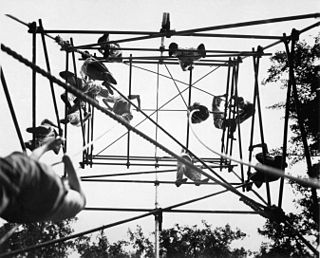
Operation Jedburgh was a clandestine operation during World War II in which three-man teams of operatives of the British Special Operations Executive (SOE), the U.S. Office of Strategic Services (OSS), the Free French Bureau central de renseignements et d'action and the Dutch and Belgian armies in exile were dropped by parachute into occupied France, the Netherlands and Belgium. The objective of the Jedburgh teams was to assist allied forces who invaded France on 6 June 1944 with sabotage and guerrilla warfare, and leading local resistance forces in actions against the Germans.
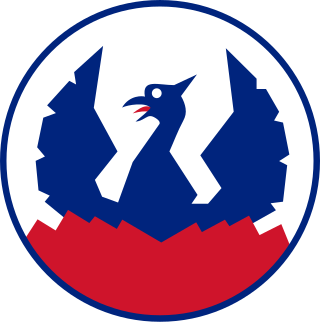
Force 136 was a far eastern branch of the British World War II intelligence organisation, the Special Operations Executive (SOE). Originally set up in 1941 as the India Mission with the cover name of GSI(k), it absorbed what was left of SOE's Oriental Mission in April 1942. The man in overall charge for the duration of its existence was Colin Mackenzie.
The Allied Intelligence Bureau (AIB) was a joint United States, Australian, Dutch and British intelligence and special operations agency during World War II. It was responsible for operating parties of spies and commandos behind Japanese lines in order to collect intelligence and conduct guerrilla warfare against Japanese forces in the South West Pacific. The AIB was formed in June 1942 to coordinate the existing Allied propaganda and guerrilla organisations. The first controller of the AIB was Colonel C. G. Roberts. At its peak the AIB contained men from ten individual services and controlled or coordinated eight separate organisations. The role of the AIB was to obtain information about the enemy, "to weaken the enemy by sabotage and destruction of morale and to lend aid and assistance to local effort to the same end in enemy territories." One member of the AIB was Alfred Deakin Brookes, who went on to become the first head of the Australian Secret Intelligence Service in May 1952.

1st Military Intelligence Battalion (Aerial Exploitation), nicknamed the "Flying Eye Battalion", is a unit of the United States Army which specializes in the acquisition of aerial signals information in direct support of the 66th Military Intelligence Brigade. 1st MI Battalion (AE) is currently headquartered at Lucius D. Clay Kaserne in Germany.
The Yan'an faction were a group of pro-China communists in the North Korean government after the division of Korea following World War II.
The United Nations Partisan Infantry Korea was a guerrilla unit during the Korean War that was consolidated under the control of United States Far East Command.

The 581st Air Resupply and Communications Wing was a United States Air Force special operations wing, last assigned to Thirteenth Air Force at Clark Air Base, Philippines, from 1951-53.
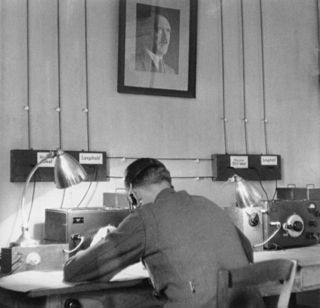
The Abwehr was the German military-intelligence service for the Reichswehr and the Wehrmacht from 1920 to 1945. Although the 1919 Treaty of Versailles prohibited the Weimar Republic from establishing an intelligence organization of their own, they formed an espionage group in 1920 within the Ministry of Defence, calling it the Abwehr. The initial purpose of the Abwehr was defence against foreign espionage: an organizational role which later evolved considerably. Under General Kurt von Schleicher the individual military services' intelligence units were combined and, in 1929, centralized under Schleicher's Ministeramt within the Ministry of Defence, forming the foundation for the more commonly understood manifestation of the Abwehr.
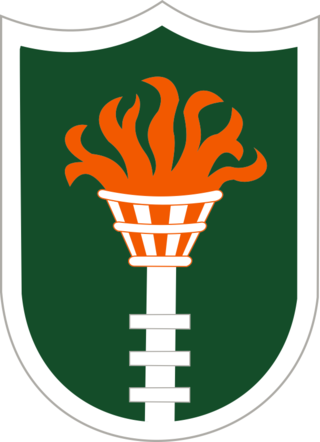
The Korean Communications Zone, abbreviated to KComZ or KCOMZ, was a United States military formation created during the Korean War with overall responsibility for the communications zone including communications, supply, and administration behind the front line, including relations with the South Korean government and the care of civilian refugees and prisoners of war.

Far East Command (FECOM) was a unified combatant command of the United States Department of Defense, active from 1947 until 1957, functionally organised to undertake the occupation of Japan and Korea. The 1st and 6th Marine Divisions, who from 1945 to 1948 assisted the Chinese government in occupying northern China, disarming the Japanese, and helping the Kuomintang Chinese without fully getting involved in the Chinese Civil War, were not part of Far East Command and reported to Pacific Command and the U.S. Navy.
The 6004th Air Intelligence Service Squadron was "the first covert collection agency in the history of the United States Air Force". Begun by Major Donald Nichols as an impromptu extension of his pre-Korean War espionage in 1950, it was first dubbed "Special Activities Unit Number One". In April or May 1951, it officially became the 6004th Air Intelligence Service Squadron. The 6004th was an unorthodox unit that engaged in espionage and aircrew escape and evasion, as well as collecting information. It was Far East Air Force's primary supplier of intelligence for the war, generating as many as 900 reports per month.
Donald Nichols was a United States Air Force intelligence officer who played a hidden but pivotal role in the Korean War. He and his spies found most of the North Korean targets destroyed by U.S. bombing during the war. Nichols also warned his superiors far in advance that North Korea was planning the surprise invasion that started the war, although his many warnings were ignored. In the first months of the war, Nichols and his men broke North Korean battle codes, which helped U.S. forces survive the invasion, halt the enemy's momentum, and destroy most of the North's army. Nichols created the Air Force's first covert intelligence unit, Detachment 2 of the 6004th Air Intelligence Service Squadron, which he commanded during most of the Korean War. His intelligence outfit, sometimes known as "Nick," saved American lives by going behind enemy lines to find vulnerabilities in Soviet tanks and MiG fighter jets. His intelligence achievements won him the Silver Star and the Distinguished Service Cross.
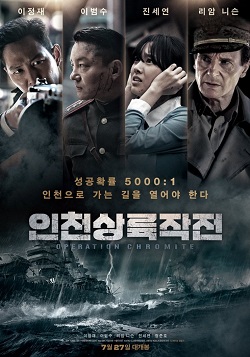
Operation Chromite or Battle for Incheon: Operation Chromite in US, is a 2016 South Korean spy war film co-written and directed by John H. Lee. It is a fiction based on a true story of Operation X-ray by ROK Navy Intelligence Unit and Operation Trudy Jackson by US Military Intelligence Unit, depicts espionages which took charge for preparatory stage of Operation Chromite in Korean War.
Operation Rat Killer was a Korean War operation carried out by Republic of Korea forces and United States advisers from December 1951 into February 1952. It was aimed at eradicating communist guerrilla forces operating in zones occupied by the United Nations forces. The operation involved two Korean Army divisions, the Capital Division and the 8th Division, several regiments of the Korean National Police, a ROKAF squadron of Mustang fighter-bombers, and about sixty United States experts. The operation was under the command of General Paik Sun Yup. The operation's particular priority was the mountainous area of Jirisan.
The Reconnaissance General Bureau is a North Korean intelligence agency that manages the state's clandestine operations. Most of their operations have a specific focus on Japan, South Korea, and the United States. It was established in 2009.
The Donkeys were a partisan force during the Korean War that consisted of anti-communist North Korean defectors who engaged in guerrilla warfare. The fighters were formed under the United Nations Partisan Infantry Forces. Guerrillas had a huge impact on the United States effort in North Korea. In the end, these partisan forces conducted 4,445 actions in North Korea that led to the capture of 950 prisoners, 5,000 weapons, 2,700 destroyed vehicles, 80 bridges demolished, 69,000 casualties, 3,189 guerrilla deaths, and only four American advisers were KIA. Furthermore, according to the 5th Air Force, of the 93 pilots who had been shot down and evaded capture between July 1950 and January 1952, guerrilla fighters rescued 29.

Ryŏdo (Korean: 려도), sometimes called Ryodo Island, Ryo-do, Yo-do or Yodo-ri, is an island in Wonsan harbor in South Hamgyong Province, North Korea.
The 8240th Army Unit was an American guerrilla unit that operated during the Korean War. It of US Army advisors who mainly trained South Korean partisans for operations in North Korea.
The White Shirts Society was a secret fascist terrorist organization that operated between World War II and the Korean War. It was mostly composed of young North Korean defectors to South Korea. It was militantly anti-communist and also opposed the trusteeship of Korea, especially by the Soviet Civil Administration in the North.
References
- ↑ The Combined Command for Reconnaissance Activities, Korea (CCRAK)
- ↑ The Army’s Guerrilla Command in Korea
- 1 2 3 4 5 6 7 Piasecki, Eugene G. (2012). "Tactical Liaison Office (TLO)". U.S. Army Special Operations History Office. Retrieved August 1, 2023.
- 1 2 3 4 Park (1998), p. 51.
- 1 2 3 Matray & Boose (2016), p. 202.
- 1 2 안, 기석 (January 11, 2005). "金日成 간담 서늘케 한 전설적 백색 테러리스트|신동아" [The Legendary White Terrorists Who Gave Kim Il Sung Chills]. 신동아 (in Korean). Retrieved August 2, 2023.
- 1 2 Finnegan (2005), p. 208.
- 1 2 Matray & Boose (2016), pp. 217–218.
- 1 2 3 4 5 6 7 Park, Yong-han; Lee, Michael (April 13, 2021). "KLO members to finally receive compensation, but not much". koreajoongangdaily.joins.com. Retrieved August 1, 2023.
- ↑ Finnegan (2005), pp. 208–209, 215.
- ↑ Finnegan (2005), pp. 208–209.
- 1 2 3 4 Park (1998), pp. 51–52.
- 1 2 3 4 "Human Rights body says gov't must pay special Korean War troops". The Hankyoreh . April 13, 2007. Retrieved August 2, 2023.
- ↑ Finnegan (2005), pp. 215–216.
- ↑ Matray & Boose (2016), pp. 218–219.
- 1 2 Finnegan (2005), pp. 217–218.
- ↑ Finnegan (2005), pp. 218–219.
- ↑ Finnegan (2005), pp. 219–220.
- ↑ Finnegan (2005), pp. 220–221.
- ↑ Finnegan (2005), pp. 221–222.
- ↑ Finnegan (2005), p. 219.
- ↑ Yoon-seung, Kang (October 14, 2021). "S. Korea to offer compensation to spy agents during Korean War". Yonhap News Agency. Retrieved August 2, 2023.
Sources
- Matray, James I.; Boose, Donald W. Jr. (March 23, 2016). The Ashgate Research Companion to the Korean War. Routledge. ISBN 978-1-317-04150-4.
- Finnegan, John Patrick (January 1, 2005), "The Intelligence War in Korea: An Army Perspective", in Neufeld, Jacob; Watson, George M. Jr. (eds.), Coalition Air Warfare in the Korean War 1950-1953
- Park, Myunglim (1998). "The 'American Boundary', Provocation, and the Outbreak of the Korean War". Social Science Japan Journal. 1 (1): 31–56. doi:10.1093/ssjj/1.1.31. ISSN 1369-1465. JSTOR 30209237.